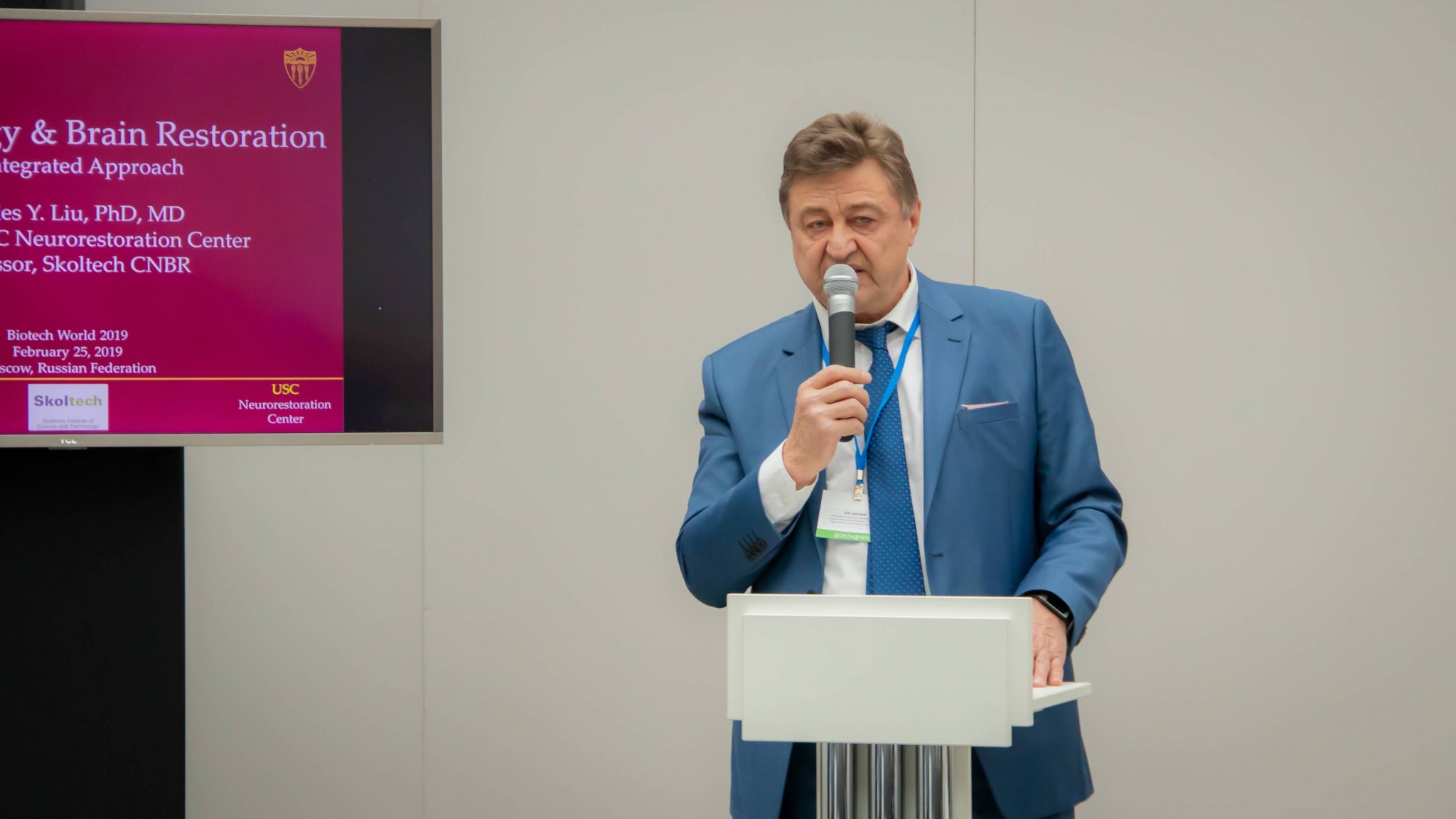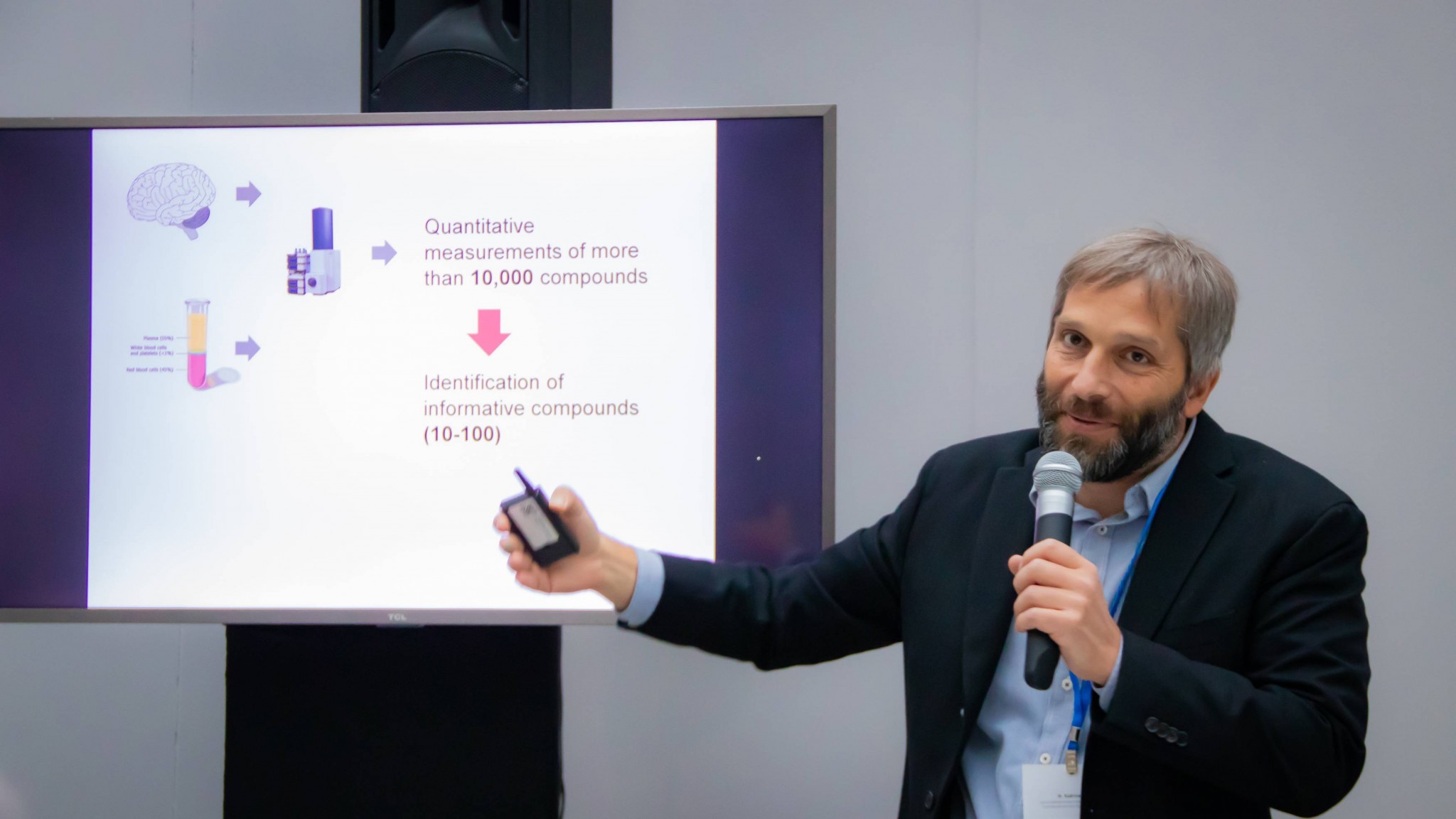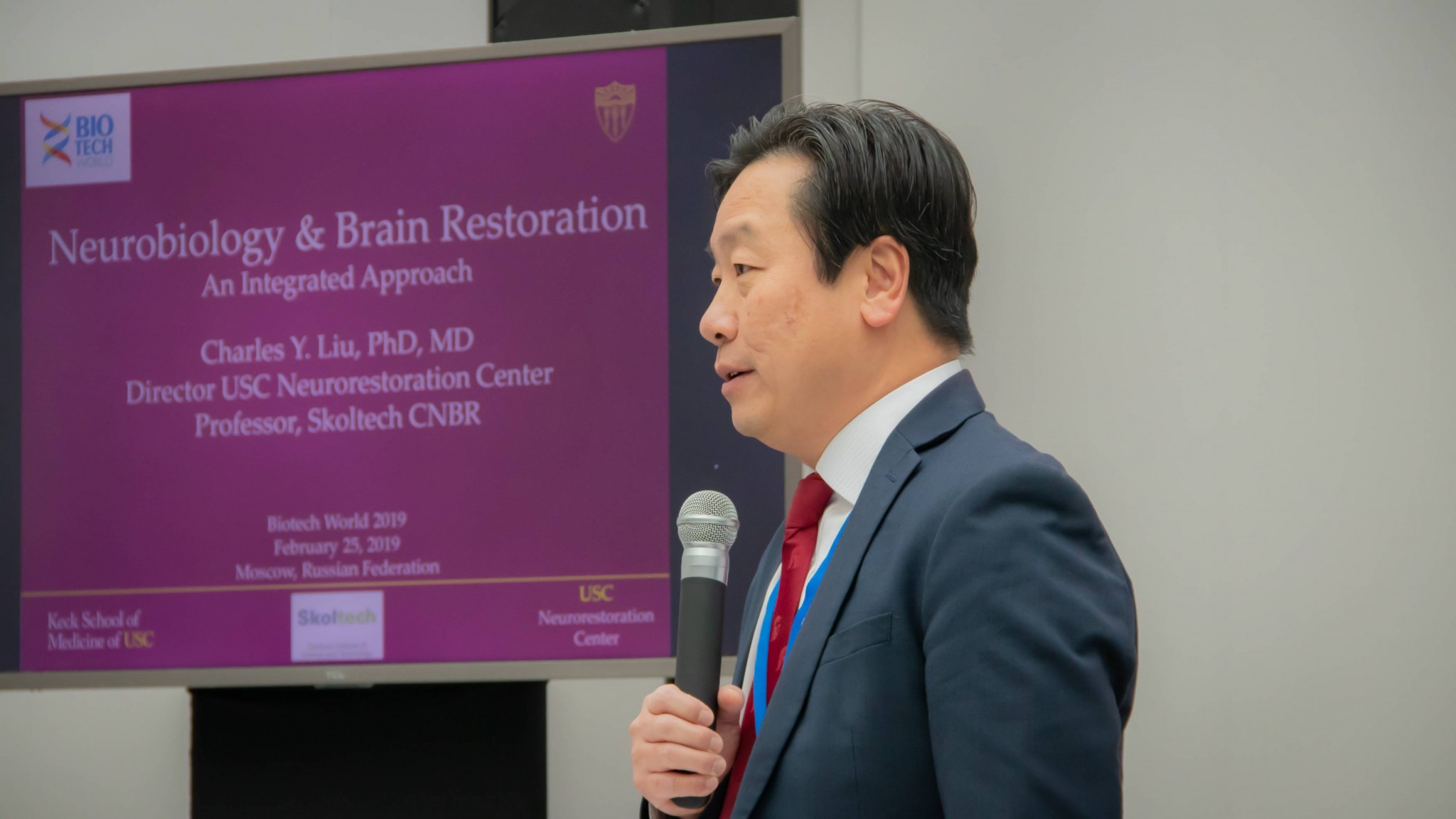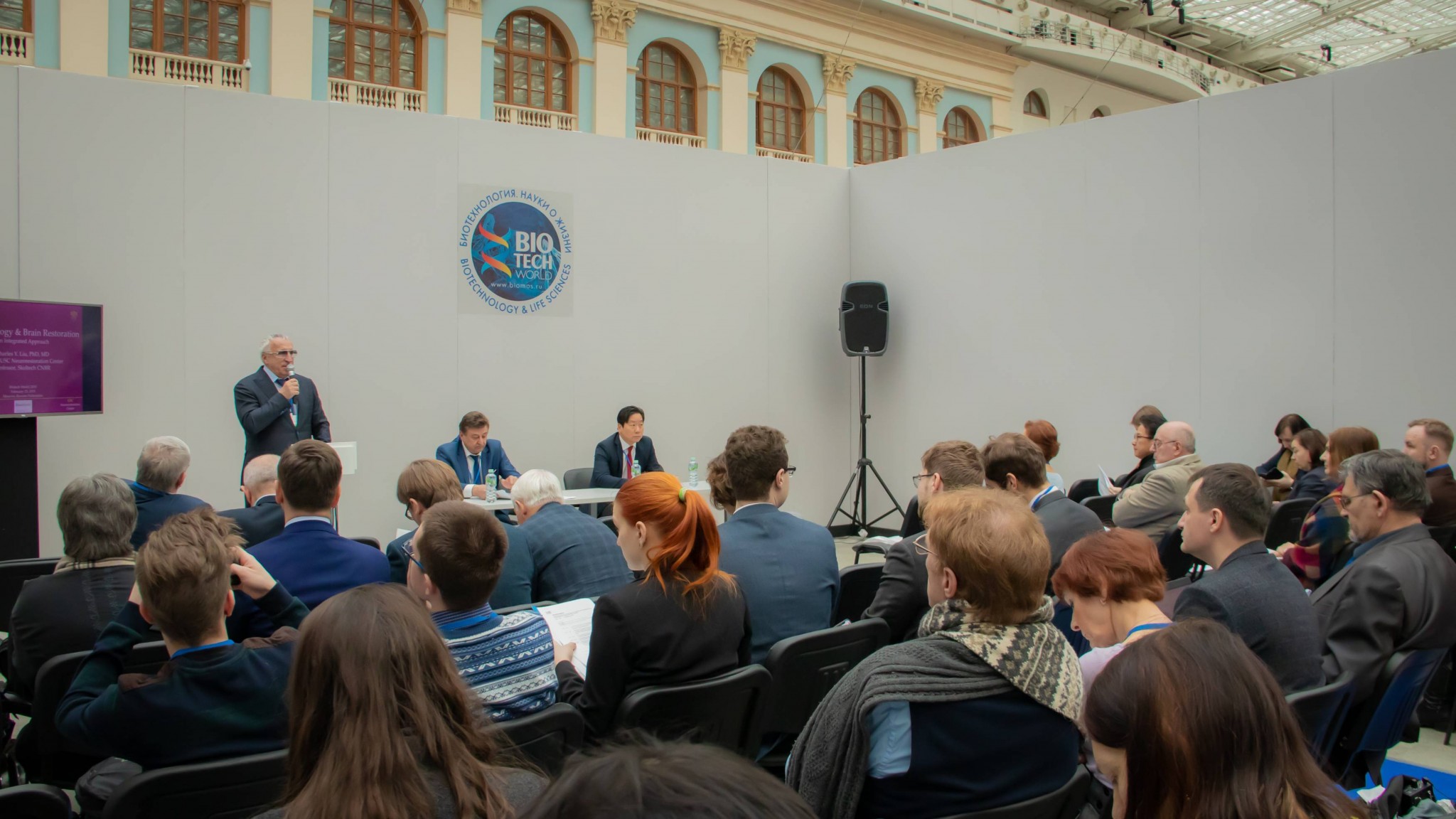
Roundtable talks, Biotech World (left to right): Skoltech President, Alexander Kuleshov, Professor Dmitry Tsyganov, and Professor Charles Liu
Biotech World is a major annual event for the field of biotechnology. At this year’s BioTech World round-table talks, “Neurobiology and Brain Restoration,” led by Professors Charles Liu (Director of USC Neuro-restoration Center) and Dmitry Tsyganov (Ministry of Science and Higher Education), the Center for Neurobiology and Brain Restoration (CNBR) brought together leading Russian and international scientists from a broad range of fields. The main focus was to present the CNBR to the Russian scientific community.
Professor Tsyganov for his part noted:
“The roundtable talk, “Neurobiology and Brain Restoration,” aimed at discussing the recent developments by leading scientists in the areas of neurobiology and neurorehabilitation, as well as a coalescence of efforts to solve fundamental engineering problems in this field.”
This was in reference to a new strategy that combines the concepts of reverse translation and basic scientific research being conducted to solve specific practical needs. We caught up with Charles Liu and Yi Jin (Research Scientist, USC Neurorestoration Center and Director, Brain Treatment Center) to discuss the round-table talks.
Can you explain neuro-restoration and brain treatment?
Charles Liu: I’ll talk about neuro-restoration. My background is in chemical engineering and bioengineering, although I initially went to medical school and became a neurosurgeon. The main reason I went to medical school is that I wanted to understand the problems facing the medical community so that I could solve those medical problems through engineering. Human beings have always solved problems through engineering. To build tools using scientific principles is the definition of engineering, so I found the idea of building tools to solve medical problems to be very appealing and that is what I wanted to spend my life doing.
As a neurosurgeon, it became clear that the ultimate challenge to the clinical neuroscience community is the ability to restore function to a damaged nervous system. For example, if you have a spinal cord injury, you’re not expected to recover. This is different to something like heart disease, where a patient can recover from a heart attack, lose weight and end up healthier than before.
I thought that the way to solve this problem is by engineering tools. What do I mean by tools? Well, a tool can be anything; it can be engineered tissue, cells, or anything else that is biological. You can engineer prosthetic devices such as artificial limbs, or neuro-prosthetic devices for brain function.
The projects that Jin and I have been working on utilize neuro-modulation strategies to take advantage of redundancy in the nervous system. This does not mean reviving dead cells, but maximizing the function of what remains.
Neuro-restoration is a new concept. It is likely that we are working the most to define what neuro-restoration is. It is a combination of approaches: to restore nervous system function after it’s been damaged; a component of it involves reparation, which is the realm of regenerative medicine; then there’s the replacing function (the neuro-prosthetics realm), and the “optimization concept,” which is for maximizing use of the redundancy of the nervous system. Those three concepts put together are what I would consider to be neuro-restoration based on engineering.
Yi Jin:
I’ll be brief. I approach this from a personal experiences and logic perspective. When I graduated from medical school, I thought that psychiatry was interesting. Very soon, I came to understand that if your brain is simple enough to be understood, then you’re too simple to understand it. In other words, you are your brain. I concluded that psychiatry by itself would not be able to solve the problems that the field faces, simply because there is no clear question to answer. For example, say a patient is diagnosed schizophrenic, my question to that is, “What is schizophrenia?” They seem to have all the scientific answers but don’t have the questions at the same precision level. I predict that the solution for mental disorders must rely on the physical understanding of how the brain operates in dealing with energy and information flow in the context of first principles in science.
For the past twenty-five years, I have been focusing primarily on research in electrophysiology, pharmacology and other studies. I came to realize that the existing field of psychiatry is held within certain boundaries that you cannot cross. I quit my academic work and set up my own company to generate revenue to support my own team. My view is that instead of categorizing illnesses as psychiatrists do, I want to know what is wrong with the brain itself. In this regard, I don’t treat disease, I treat the brain. I am therefore more concerned with the underlying nervous system rather than the phenomena of clinical symptoms.
We use a physical probe to try and identify the problem. I use an algorithm that I developed along with a normative database; you compare each individual’s brainwaves with the database to see how far they deviate from the norm. If your deviation is too far to one side or the other, I would consider you abnormal and my goal would be to bring you into the middle.
We found that the brain has all the mechanical features that every other machine has; it works exactly as any machine would in physics. For example, take a combustion engine; a car has coolant and a radiator to cool it off, which is determined by a thermodynamic law. Our brain works by following the same physical law except for a different cooling mechanism.
We found that neurons are very efficient at propelling heat, and a condition such as anxiety is simply a case of overheated neurons. Schizophrenia, during a certain phase of illness development, is a case of the brain being much hotter than normal and encoding neural information abnormally. How do you help a patient in this scenario? You need to restore the symmetry patterning within the brain to slow it down, cool it off, and normalize its information process. If your brain is too cold, for example with Alzheimer’s disease or major depressive disorder, you may help speed it up a little bit to increase the brain metabolism and blood perfusion.
Charles Liu:
One point of clarification, when Jin talks about “hot” and “cold,” he’s talking about energy states.
Yi Jin:
Yes, temperature is a factor, but it’s very minor in comparison to other factors that we use to measure “hot” and “cold” brain states. We’re talking about the brain’s metabolic rate.
Charles Liu:
When you see a PET scan that has a bright spot – a hot spot – that is an indicator of a high metabolic rate. A cold spot is a “low” metabolic rate.
Yi Jin:
Schizophrenia is a case of overactive neurons, or neurons that are active in a chaotic way; there is a physical law called the “symmetrical conservation” law. Assuming your system works like a sinusoidal wave, energy that drives it is conserved so that you have zero metabolism; but if your wave becomes very irregular, then your system tends to burn more energy. This is a law of physics. The majority of mentally ill patients have a desynchronized irregular waveform, which often results in anxiety, panic, mania, and schizophrenia, etc. We developed the idea to measure your intrinsic frequency – the dominant frequency that’s supposed to be there – then we use your brainwave to drive a very powerful magnetic pulsing machine via an electric coil to send electromagnetic pulses into your brain to guide your neurons to fire properly. Through a certain type of stimulation, your neurons begin to operate normally and a mentally ill patient falls into a state of calm.
Charles Liu:
The point is that abnormal alterations in brain function can be used to describe illnesses such as Alzheimer’s, epilepsy, depression and so on. The focus is not on categorizing the illness, but on focusing on the brain function that is the underlying cause of such brain illnesses.
What key problems and novel solutions did you identify during this roundtable discussion?
Charles Liu:
From our perspective, we found the roundtable discussion to be very stimulating, because in our view the participants were very innovative and experienced. Because they come from a different scientific system than what we’re used to, we found this to be very refreshing. Science is like music; there are certain rules and frameworks to follow, but in following these, you can create many different versions of it. If you are listening to the same kind of music all the time and then you listen to a different type of music that follows the same rules, it’s extremely refreshing.
I found that the overall premise of what is driving the solutions will predetermine what the solutions will be. In the United States, the dominant presence of pharmaceutical companies in medicine means that there is a huge emphasis on discovering new drugs. Given that there isn’t as much of that pressure here, we saw that people are using physical procedures to treat psychiatric disorders, which is similar in principle to what you’re [Yi Jin] doing. In general, the problems that people face from a health perspective here are very similar to the problems that people face round the world in general.
One thing that we tried to do was to describe or imagine a different approach to creating solutions for these problems. With respect for everybody’s effort, of which we are a part, if you look at the problems that the world is facing – whether it be with dementia, autism, type 2 diabetes, metabolic syndromes – they’re all continually increasing. If you think of the solutions that are being created within the conventional paradigm, I don’t see this approach slowing the current trend. The key is trying to come up with a different way to understand it that isn’t as reductionist as the conventional approaches and thinking about basic questions, such as why these increases are happening. I would like to add that when we say “increase,” we mean that these illnesses are increasing per capita.
Yi Jin:
If we look at the level of dementia among old people in the current population and compare it to the same demographic fifty years ago, the prevalence is much higher. What impressed me in particular about yesterday’s meeting is that when you look at today’s science, there are so many products available to deal with individual problems, such as lipid measures, but not many theories to address the system issues as a whole. The result is that there are a lot of specialists, even though our biological system is a whole complex machine; it’s a very non-linear, multi-variant integrated thing. You cannot consider parts of interconnected systems in isolation; for example, you cannot think about one’s heart without thinking about the brain, nor can you think about your limbs without thinking about the nerves; nothing works like that. Yesterday, I saw all these specialists contributing to their own area; it’s a good time to approach this with a system view rather than a particle view. A non-linear, chaotic way to look at the system is to say that one plus one is greater than two. When you take all these specialists and put them together, the full picture is greater than the numerical sum of all the individual things. When I see this happening under the same leadership umbrella, it’s exciting that they all intend to work together; you don’t see this type of phenomenon in other places.
Charles Liu:
I think that credit for this should go to Vladimir Zelman, even though he couldn’t attend. We’re here as part of the Center of Neurobiology and Brain Restoration; there are key people here and Jin and I are key collaborators in key parts of the center. The center director is Fabio Macciardi and Vladimir Zelman is the principal driver behind the center’s creation. The round table was comprised of people that were invited to help realize this concept; the concept of the center is to take a highly non-conventional approach to solving problems that maximizes the strengths of a technical university that isn’t constrained by its history of preconceived notions. Not being of the medical field leaves you without a preconceived notion of what the solution ought to look like; there’s a fresh perspective that is grounded by the expertise and knowledge base of the clinical and basic neurosciences. That’s the idea behind the center – it’s meant to be highly collaborative, it’s meant to be international, it’s meant to be multi-disciplinary, all of which should characterize a modern effort. The purpose of the roundtable, which was part of the 2019 BioTech World, was to bring the key collaborators and have them present what they did.
BioTech World has been going on for seventeen years and my understanding is that within the last couple of years there has been a real effort in expanding the scope of the focus. When you look at what is considered biotechnology, that definition is rapidly expanding. When I was a chemical engineering PhD student in the late 1980s, biotechnology was very narrow. There was a large emphasis on industrial biotechnology using bacteria, fermentation processes to create an industrial product, or biomedical technology; now, the scope involves all technology that is of biology – all technology that is by biological systems. I think that biotechnology includes all technology that affects our biology as a principal focus; for example, AI is designed to direct your behavior in order to sell you stuff. Why is that not biotechnology? It’s designed to influence your brain as a principal purpose. That entire set of activities that humanity is involved in can be categorized in some regards as biotechnology.
When we look at the scope of what was covered at the meeting, we saw a nice array of these things. Established in the last quarter of 2018, the CNBR is very new; its focus is to find innovative solutions to problems within an international setting. Having this roundtable was a very important step towards getting all our collaborating institutions to understand what our goals and objectives are and for us to understand what theirs are; this is so that we can find common goals that would operationalize the center’s vision.
Where do you see this going in the coming years?
Charles Liu:
The CNBR is already very strong with the work of existing members, such as Philipp Khaitovich and Mikhail Belyaev amongst others. Under our director, Fabio Macciardi, we want to identify some key priority issues – maximizing the strengths of a technical university that is in the computational, mathematical, machine learning areas and so on, and using these as a way to help us quantify aspects of neurological functions. The other high priority project – again, because our efforts are project-based – is based on using some of the concepts that Jin has developed on energy states in the brain, how to use magnetic pulses to change these energy states and apply that to the likes of dementia, autism and such. The center has identified these two as priority projects and we intend to take and make sure that they align with the existing priorities of the CNBR in neurobiology and neurogenetics.
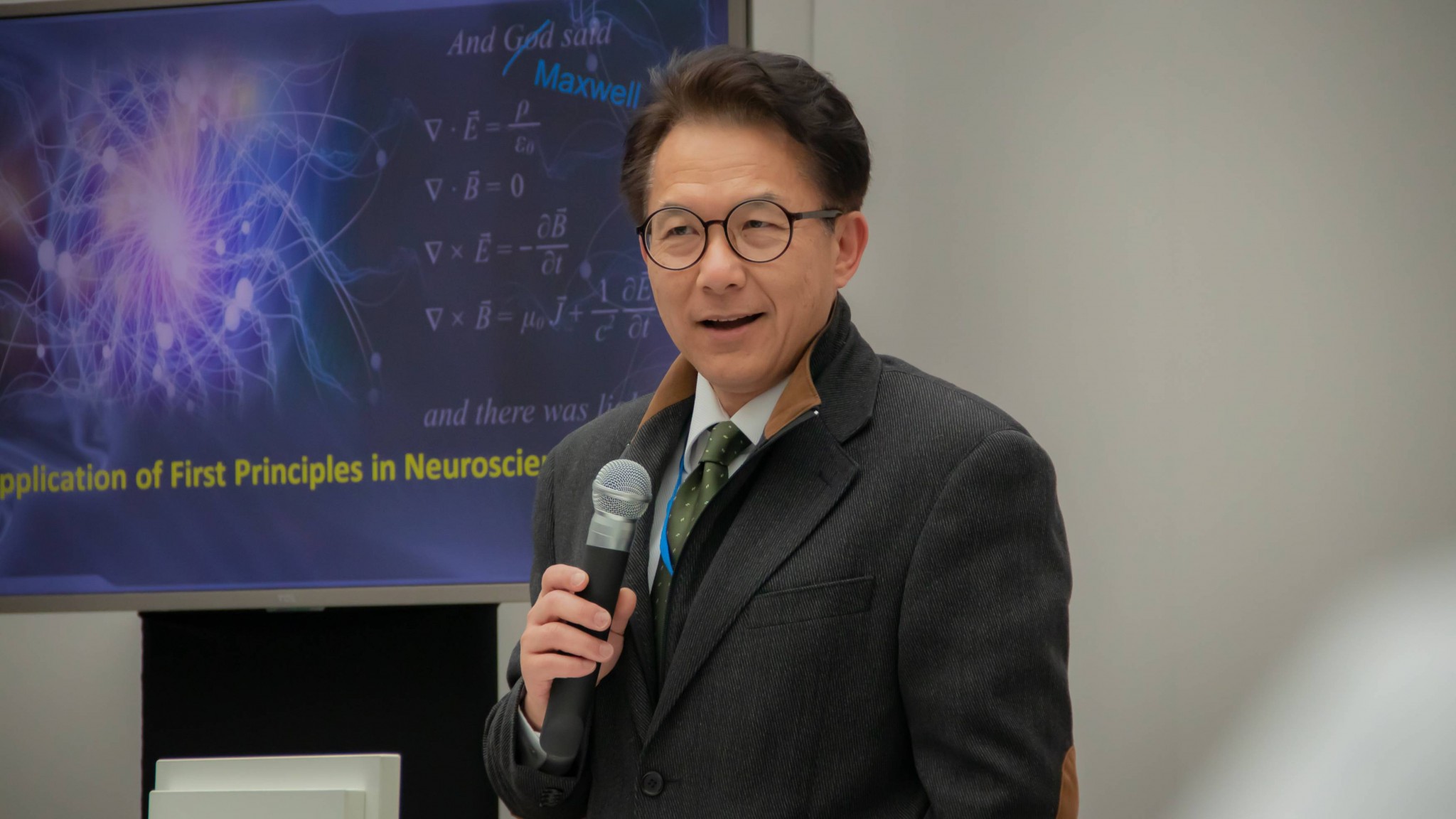
Image: Professor Yi Jin (Research Scientist, USC Neuro-restoration Center and Director, Brain Treatment Center)
Skoltech President, Alexander Kuleshov, comments on this recent event:
“I believe that following the age of genetics that reigned in science at the end of the 20th century and beginning of the 21st century, the next two to three decades will usher in an era of neuroscience.
Skolkovo Institute of Science and Technology regards neuroscience as one of its priority research areas. Skoltech’s Neuroscience Center, which was established in September 2018, made a noticeable contribution to the conference, both in terms of research presented and organizational support.”
Contact information:
Skoltech Communications
+7 (495) 280 14 81
